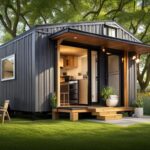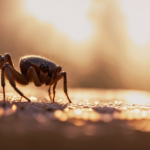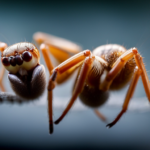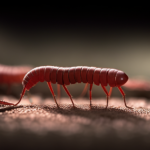Beginners Guides
What Are The Tiny Spiders In My House

While sitting in my living room, a small spider quickly moved across the floor, drawing my focus. This sparked my curiosity about the different types of spiders that make their homes alongside us.
You see, these eight-legged creatures are not just pests; they are fascinating arachnids with unique characteristics and behaviors. In this article, we will delve into the world of house spiders, those minuscule creatures that often go unnoticed.
By exploring common types, identifying their habits, and discussing prevention and removal methods, we will unravel the mystery of these tiny spiders. Contrary to popular belief, many house spiders are harmless and even beneficial to have around. However, we will also address any concerns regarding their potential dangers and debunk common misconceptions.
So, if you’ve ever wondered about the tiny spiders in your house and how to coexist with them harmoniously, read on for a scientific exploration into their intriguing world.
Key Takeaways
- House spiders are commonly found in residential areas and are attracted to areas with abundant prey.
- Understanding the physical characteristics and behavior of house spiders can determine if they are harmless or potentially harmful.
- Venomous spiders, like black widow and brown recluse spiders, can pose a potential health risk to humans and prompt medical attention is necessary if bitten.
- Controlling spider infestations requires a multi-faceted approach including sealing cracks, regular cleaning and decluttering, and using natural remedies and homemade traps.
Common Types of House Spiders
You may come across tiny spiders in your house, scurrying along the walls and hiding in the corners. These spiders belong to various species commonly found in residential areas. To identify them, you can use certain techniques that focus on their physical characteristics and behavior.
One common type of tiny house spider is the cellar spider, easily recognizable by its long, thin legs and small body size. Another species is the cobweb spider, known for its ability to spin messy webs in corners and crevices. These spiders often seek shelter in common hiding spots such as dark corners, basements, and attics. They are attracted to areas with abundant prey, like flies and other small insects.
Understanding the identification techniques and common hiding spots of these tiny spiders can help you determine if they are harmless house spiders or potentially harmful species.
Transitioning into the subsequent section, it is important to also explore the identification and habits of house spiders in more detail.
Identification and Habits of House Spiders
Curious about those little arachnids scurrying around indoors? Let’s explore the fascinating world of house spiders and learn about their identification and habits! House spiders are commonly found in homes and can belong to various species. Understanding their behavior can help us coexist peacefully with these eight-legged creatures.
To better understand house spiders, let’s take a look at some common spider species and their characteristics. The table below provides a quick overview:
| Spider Species | Size | Color | Web-building Habit | Habitat |
|---|---|---|---|---|
| Common House Spider | Small | Brown or gray | Builds tangled webs | Found in dark corners |
| Cellar Spider | Small | Pale yellow | Builds delicate webs | Often found in basements |
| Daddy Longlegs | Small | Brown | Doesn’t build webs | Found in secluded areas |
| Wolf Spider | Medium to large | Brown | Doesn’t build webs | Active hunters |
Understanding the habits of house spiders can help demystify their behavior. House spiders are generally nocturnal and prefer to hide in dark corners or behind furniture during the day. They build webs to catch prey and lay eggs, which can result in an increase in spider populations if left unchecked.
Now that we’ve explored the identification and habits of house spiders, let’s delve into the question: "Are house spiders harmful?"
Are House Spiders Harmful?
When it comes to house spiders, it’s important to understand the difference between venomous and non-venomous species. Venomous spiders can pose a potential health risk to humans, while non-venomous spiders are generally harmless.
Controlling spider infestations is crucial to prevent any potential health risks and maintain a safe living environment.
Venomous vs. Non-venomous Spiders
Contrary to popular belief, some tiny spiders in your house may be venomous, while others are harmless. It is important to understand the distinction between venomous and non-venomous spiders to ensure your safety.
Venomous spider bites can lead to various symptoms, including localized pain, redness, swelling, and itching. In more severe cases, systemic symptoms such as nausea, dizziness, and muscle pain may occur. Identifying the specific type of spider is crucial in determining the potential health risks associated with a bite. It’s recommended to capture the spider, if possible, for proper identification by a professional.
Understanding the venomous vs. non-venomous spiders in your house can help you assess the level of risk and take appropriate measures to prevent spider bites.
Transitioning into the subsequent section about potential health risks, it’s crucial to be aware of the potential dangers these spiders pose to your well-being.
Potential Health Risks
To safeguard your well-being, it’s important to be aware of the potential health risks that venomous spiders may pose. Venomous spiders, such as the black widow or brown recluse, can inject venom into their prey or when they feel threatened.
Bites from these spiders can cause a range of medical concerns, including severe pain, swelling, and tissue damage. In some cases, the venom can lead to systemic reactions, such as fever, nausea, and muscle pain. Although rare, allergic reactions can also occur, which may manifest as difficulty breathing, dizziness, or even anaphylaxis.
It’s crucial to seek immediate medical attention if bitten by a venomous spider, as prompt treatment can help mitigate potential dangers. With an understanding of the risks involved, let’s now explore effective methods for controlling spider infestations.
Controlling Spider Infestations
Now that we understand the potential health risks associated with tiny spiders in our houses, it’s important to discuss effective methods for controlling spider infestations.
Controlling spider populations requires a multi-faceted approach, combining both chemical and non-chemical methods. One effective way to deter spiders is to use spider repellents that contain ingredients such as peppermint oil, vinegar, or citrus. These natural repellents disrupt the spiders’ ability to navigate and communicate, making your home less attractive to them.
Additionally, sealing cracks and crevices in your home’s exterior can prevent spiders from entering in the first place. Regularly cleaning and decluttering your home is also crucial, as spiders are attracted to dark and cluttered areas.
By implementing these measures, you can reduce the presence of spiders in your home and create a more comfortable living environment. Moving forward, let’s explore the prevention and removal of house spiders.
Prevention and Removal of House Spiders
Additionally, there are effective methods for preventing and removing house spiders. Spider infestations can be a nuisance, but with proper prevention and removal techniques, you can keep your home spider-free. One way to prevent spider webs from forming in your house is to regularly clean and declutter your living spaces. Spiders are attracted to cluttered areas as they provide hiding spots and prey. By keeping your home tidy and organized, you can discourage spiders from making themselves at home. Another effective method is spider proofing your home by sealing any cracks or openings that spiders can use to enter. Use caulk to seal gaps around windows, doors, and utility pipes, and install weather stripping to prevent spiders from finding their way indoors. Additionally, installing screens on windows and doors can act as a physical barrier, preventing spiders from entering your home. By following these preventive measures, you can significantly reduce the chances of spider infestations in your house.
| Prevention Methods | Benefits |
|---|---|
| Regular cleaning and decluttering | Discourages spiders from settling in |
| Sealing cracks and openings | Prevents spiders from entering your home |
| Installing screens | Acts as a physical barrier for spiders |
| Spider proofing your home | Reduces the chances of spider infestations |
With these proven prevention techniques in place, you can now focus on natural ways to get rid of house spiders without the need for harsh chemicals or pesticides.
Natural Ways to Get Rid of House Spiders
Imagine walking into a cozy, spider-free home, where natural remedies keep those eight-legged creatures at bay. When it comes to getting rid of house spiders, there are several natural spider repellents and homemade spider traps that can help.
One effective natural spider repellent is peppermint oil. Spiders dislike the strong scent of peppermint, so mixing a few drops of peppermint oil with water in a spray bottle and spraying it around windows, doors, and other spider-prone areas can deter them.
Another natural repellent is vinegar. Spiders are also repelled by the smell of vinegar, so wiping down surfaces with a solution of vinegar and water can help keep them away.
Homemade spider traps can be made using a jar, some tape, and a piece of cardboard. Simply place the cardboard inside the jar and tape it to the outside, creating a ramp for the spiders to climb. Add some bait, like a piece of fruit, and leave the trap overnight. The spiders will be attracted to the bait and get trapped inside the jar.
With these natural remedies and homemade traps, you can take proactive steps to keep your home spider-free.
Now, let’s debunk some spider myths and misconceptions.
Spider Myths and Misconceptions
Contrary to popular belief, there are many misconceptions surrounding spiders and their behavior. To truly understand these fascinating creatures, it’s essential to delve into their intricate world.
Spider behavior is complex and varies among different species. One common misconception is that all spiders are aggressive and dangerous. While some spiders may bite if threatened, most spiders are actually quite timid and prefer to avoid human interaction altogether.
Another misconception is that spiders are constantly reproducing. In reality, spiders have a specific reproductive cycle. Mating typically occurs in the spring or summer, and the female spider will lay her eggs shortly afterward. The eggs are then carefully guarded by the female until they hatch. It’s important to note that not all spiders reproduce at the same rate, and some species may only reproduce once in their lifetime.
Understanding spider behavior and their reproductive cycle can help dispel these misconceptions and foster a greater appreciation for these beneficial creatures. In fact, house spiders play a vital role in controlling insect populations, making them a valuable asset in any home.
Benefits of Having House Spiders
Having house spiders in your home can be beneficial because they help control the population of insects, but have you ever considered the other advantages they bring? In addition to being natural pest control, house spiders offer a range of benefits that debunk common spider fears. Let’s explore these benefits and gain a deeper appreciation for these eight-legged creatures.
| Benefits of House Spiders | Debunking Spider Fears | Other Advantages |
|---|---|---|
| Natural pest control | Non-venomous bites | Aesthetic appeal |
| Reducing allergies | Limited aggression | Minimal noise |
| Decreasing diseases | Restoring ecosystems | Ecologically friendly |
House spiders excel at controlling the population of insects, eliminating the need for chemical pesticides. They help to reduce allergies by catching and eliminating common allergens like dust mites. Contrary to popular belief, most house spiders have non-venomous bites that rarely cause harm to humans. These arachnids are generally not aggressive and will only bite when threatened.
Furthermore, house spiders contribute to the aesthetic appeal of your home by creating intricate webs. Their presence adds a touch of nature indoors. Unlike other household pests, house spiders are quiet and unobtrusive. They do not produce noise or disturb your peace.
As we appreciate the benefits of house spiders, it’s important to also consider the advantages of other common household arachnids, such as scorpions and harvestmen.
Other Common Household Arachnids
After discussing the benefits of having house spiders, it’s important to also be aware of other common household arachnids that may be present in your home.
These arachnids include ticks, mites, and scorpions.
Ticks are small arachnids that are known for feeding on the blood of mammals, birds, and reptiles. They can transmit diseases such as Lyme disease and Rocky Mountain spotted fever, making them a potential health concern.
Mites, on the other hand, are tiny arachnids that can be found in various habitats, including homes. Some species of mites can cause allergies or skin irritations in humans.
Lastly, scorpions are arachnids that are known for their venomous stings. While they are more commonly found in arid regions, some species can be found in homes, especially in warmer climates.
To control these common household insects, it’s important to maintain cleanliness and minimize potential hiding spots. Regularly vacuuming and dusting can help eliminate mites and ticks, while sealing cracks and crevices can prevent scorpions from entering your home. Additionally, it’s advisable to remove any clutter or debris from your surroundings.
By taking these spider control methods into consideration, you can create a more harmonious living environment with house spiders.
Tips for Living Harmoniously with House Spiders
When it comes to living harmoniously with house spiders, there are a few key points to keep in mind.
First, it’s important to educate yourself about spiders, their behavior, and their role in the ecosystem. This will help you understand that most spiders found indoors are harmless and actually beneficial.
Second, maintaining a balanced indoor environment by reducing clutter, keeping your home clean, and minimizing areas where spiders can hide will help discourage their presence.
Finally, if you’re dealing with a spider infestation that you can’t handle on your own, it’s best to seek professional help from a pest control expert who can safely and effectively address the issue.
Educate Yourself about Spiders
To better understand the tiny spiders in your house, take a moment to educate yourself about these fascinating creatures.
Spider anatomy plays a crucial role in their behavior and survival. Spiders have two body parts: the cephalothorax and the abdomen. The cephalothorax contains the spider’s eyes, mouthparts, and legs, while the abdomen houses the digestive system and reproductive organs.
Spiders are known for their ability to produce silk, which they use to build webs for catching prey or creating shelters. They have specialized hairs on their legs called trichobothria, which are sensitive to vibrations in the air or on surfaces, helping them detect potential threats or prey.
Understanding spider anatomy and behavior can help you maintain a balanced indoor environment that’s conducive to both your comfort and their survival.
Maintain a Balanced Indoor Environment
Creating a balanced indoor environment ensures a harmonious coexistence between humans and the eight-legged inhabitants. To maintain indoor humidity at an optimal level, it’s essential to use a humidifier or dehumidifier depending on the climate. This helps prevent excessive moisture that can attract spiders.
Additionally, minimizing clutter is crucial as it reduces potential hiding spots for spiders and their prey. Regularly decluttering and organizing your space, especially in dark and damp areas, can significantly deter spider populations.
Furthermore, sealing cracks and gaps in walls, windows, and doors prevents spiders from entering your home. By following these measures, you can create an environment that discourages spider infestations.
Remember, seeking professional help is advisable if spider populations persist, as they may indicate a larger underlying issue.
Seek Professional Help if Needed
Sometimes, it’s best to call in the experts if you’re dealing with a persistent spider problem in your home. Seeking professional help can ensure a thorough assessment of your situation and provide effective solutions.
But when should you consider making that call? If you have a large infestation that persists despite your efforts to eliminate it, or if you’re dealing with potentially dangerous spiders, it’s time to seek professional assistance.
Spider experts have the knowledge and experience to identify the species, assess the extent of the infestation, and determine the best course of action. They can use specialized tools and techniques to safely remove spiders and their webs, while also addressing the underlying causes to prevent future infestations.
Don’t hesitate to reach out to professionals when dealing with a spider problem that you can’t handle on your own.
Frequently Asked Questions
Can house spiders bite humans?
Yes, house spiders can bite humans. Their behavior is usually non-aggressive, and they only bite when they feel threatened or cornered. House spider bites typically result in mild symptoms such as localized pain, redness, and swelling at the bite site. In rare cases, some individuals may experience allergic reactions or more severe symptoms. It’s important to seek medical attention if you suspect a house spider bite, especially if symptoms worsen or persist.
How long do house spiders typically live?
On average, house spiders typically live for about one to two years. However, their lifespan can be influenced by various factors such as temperature, humidity, availability of food, and presence of predators. These tiny arachnids, despite their short lives, play a crucial role in controlling insect populations in our homes.
As the saying goes, "Every spider has its day," and house spiders diligently carry out their predatory duties until their time comes to an end.
Can house spiders cause any damage to my property?
House spiders can cause potential damage to property. They can create unsightly cobwebs and leave droppings. Additionally, their bites can cause irritation and allergic reactions in some individuals.
To prevent house spiders from entering your home, ensure all cracks and openings are sealed, use screens on windows and doors, and keep your home clean and clutter-free. Regularly vacuuming and removing spider webs can also help reduce their presence.
Are house spiders attracted to certain types of materials or fabrics?
House spiders aren’t specifically attracted to certain types of materials or fabrics. They’re more commonly found in dark, undisturbed areas like basements, attics, and crawlspaces. However, it’s important to note that house spiders can inadvertently be attracted to areas with a high presence of insects, which may be attracted to certain materials or fabrics.
House spiders can provide potential benefits by controlling the population of these insects, thus reducing the risk of infestations and damage to property.
How can I distinguish between a house spider and a more dangerous species of spider?
To distinguish between a house spider and a more dangerous species, look for distinguishing characteristics. House spiders typically have a small body size, ranging from 3-10mm, and a brown or gray coloration. They have two main body segments and eight legs.
When it comes to common locations, house spiders can be found in dark, undisturbed areas such as basements, attics, and closets. Remember, if you’re unsure about the species, it’s best to consult with a professional.
Conclusion
In conclusion, living with house spiders can be quite beneficial. Although their presence may be unsettling to some, these tiny arachnids play a crucial role in controlling other insect populations in our homes.
By catching and feeding on flies, mosquitoes, and other pests, house spiders act as natural pest control agents, helping to maintain a balanced ecosystem within our living spaces.
So, the next time you come across a small spider scurrying across your floor, remember that it’s just another helpful housemate, quietly doing its job.
Hi, I’m Emma. I’m the Editor in Chief of Tiny House 43, a blog all about tiny houses. While tree houses are often associated with childhood, they can be the perfect adult retreat. They offer a cozy space to relax and unwind, surrounded by nature. And since they’re typically built on stilts or raised platforms, they offer stunning views that traditional homes simply can’t match. If you’re looking for a unique and romantic getaway, a tree house tiny house might just be the perfect option.
Beginners Guides
How Did the City of Fresno to Tiny House

As someone living in Fresno, I have always believed in the saying ‘home is where the heart is.’ Thanks to the city’s forward-thinking housing policies, even the smallest of homes can now have a place to call their own.
In this article, we’ll explore how Fresno has embraced the tiny house movement, collaborating with advocates and implementing innovative zoning regulations. Join me as we delve into the challenges faced and the remarkable progress made towards building a thriving tiny house community in Fresno.
Key Takeaways
- Fresno has implemented housing policies and initiatives aimed at increasing access to affordable housing, including energy-efficient homes and tiny house construction.
- Collaboration with tiny house advocates is crucial for effective housing solutions, as they bring valuable insights and innovative ideas to the table.
- Zoning regulations and permitting processes in Fresno are designed to engage the community and ensure that their needs and preferences are considered.
- Fresno has created innovative tiny house communities that focus on sustainability and affordability, incorporating features such as solar panels and rainwater harvesting systems.
The Shift in Housing Policies
I’m excited to talk about the changes happening in housing policies.
One of the most pressing issues in our society today is housing affordability. Many individuals and families struggle to find affordable housing options, causing financial strain and instability.
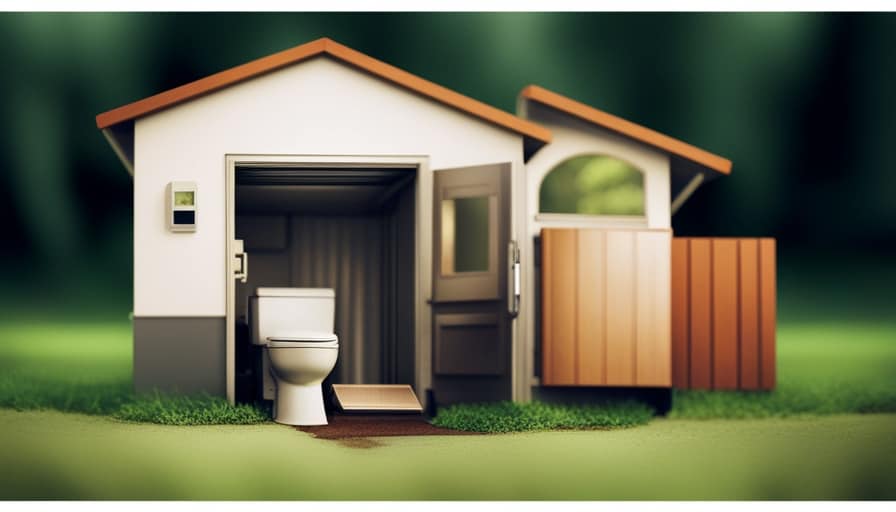
As a result, there’s been a shift in housing policies towards promoting sustainable living and increasing access to affordable housing. Governments and organizations are recognizing the importance of creating housing opportunities that are both environmentally friendly and economically viable.
This involves initiatives such as promoting energy-efficient homes, supporting the construction of tiny houses, and implementing rent control measures.
Collaborating With Tiny House Advocates
Collaborating with tiny house advocates has been crucial in implementing effective housing solutions in the city of Fresno. Through collaboration strategies and community engagement, we’ve been able to work hand in hand with advocates to address the unique challenges and opportunities that tiny houses present.
These collaborations have allowed us to tap into the knowledge and expertise of tiny house advocates, who bring valuable insights and innovative ideas to the table. We’ve engaged in open and transparent dialogues, fostering a sense of trust and understanding between all parties involved.

Zoning Regulations and Permitting Processes
Navigating the complexities of zoning regulations and permitting processes can be challenging, but it’s essential for ensuring the successful implementation of tiny house communities in the city of Fresno.
To streamline processes and make it easier for individuals and organizations to develop tiny house communities, the city of Fresno has taken steps to engage with the community and actively involve them in the decision-making process.
This includes hosting public meetings, soliciting feedback, and conducting thorough assessments of potential sites for tiny house communities. By involving the community in these processes, the city of Fresno can address any concerns or issues that may arise, while also ensuring that the needs and preferences of the community are taken into consideration.
This collaborative approach not only helps to build trust and support, but also allows for a more efficient and effective implementation of tiny house communities in the city.

Innovative Tiny House Communities in Fresno
One innovative approach to creating tiny house communities in Fresno is through the use of sustainable materials and renewable energy sources. These communities are designed with a focus on sustainability, incorporating features such as solar panels, rainwater harvesting systems, and energy-efficient appliances. By utilizing these sustainable practices, residents can reduce their carbon footprint and live in homes that are environmentally friendly.
Additionally, these communities aim to provide affordable living options for individuals who may not be able to afford traditional housing. Through the use of smaller, more efficient spaces, the cost of construction and maintenance is reduced, making it more accessible for those on a limited budget.
These innovative tiny house communities in Fresno are paving the way for sustainable housing and promoting affordable living for all.
Transitioning into the next section, let’s explore the challenges faced in building a tiny house movement.

Overcoming Challenges and Building a Tiny House Movement
Confronting obstacles and working together, we can create a thriving tiny house movement in Fresno.
To overcome challenges and build a sustainable and affordable housing solution, we must first address zoning regulations. Currently, many cities have restrictions that make it difficult to build tiny houses on a permanent foundation. By advocating for changes in zoning laws, we can create more opportunities for tiny house communities.
Additionally, we need to address financing options for individuals interested in building tiny houses. Traditional lending institutions may not provide loans for these unconventional homes, so alternative financing options must be explored. Collaborating with local government, community organizations, and financial institutions can help us develop innovative solutions to overcome these challenges.
Frequently Asked Questions
How Long Does It Typically Take to Build a Tiny House?
Typically, it takes around 2-4 months to build a tiny house. The building timeline can vary based on factors like design complexity, availability of materials, and contractor availability. Cost considerations include materials, labor, and permits.
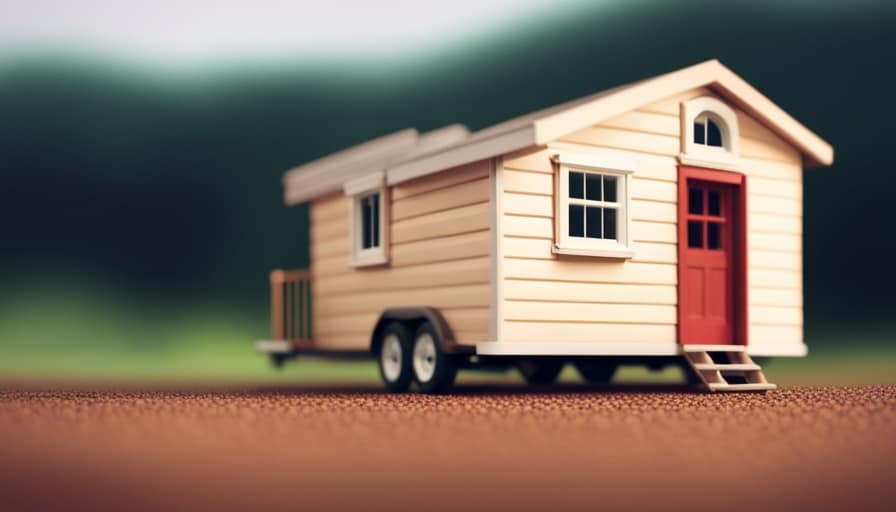
Are There Any Specific Requirements for the Size or Design of a Tiny House in Fresno?
In Fresno, specific requirements exist for the size and design of tiny houses. The city has set guidelines to ensure safety and conformity. Meeting these requirements is crucial to obtaining necessary permits and building a legally compliant tiny house.
Can I Legally Live in a Tiny House on Wheels in Fresno?
Yes, you can legally live in a tiny house on wheels in Fresno. While specific regulations may vary, other cities have implemented tiny house regulations with benefits such as affordability, sustainability, and minimal environmental impact.
How Can I Find Resources and Support for Building My Own Tiny House in Fresno?
Finding local workshops and connecting with tiny house builders in Fresno is crucial for building my own tiny house. Through thorough research and analytical thinking, I can discover resources and support to ensure a successful project.
Are There Any Financial Incentives or Grants Available for Individuals Interested in Building a Tiny House in Fresno?
There are financial assistance programs and grants available for individuals interested in building a tiny house in Fresno. It’s important to familiarize yourself with the building regulations and requirements to ensure compliance.

Conclusion
In conclusion, the city of Fresno has successfully embraced the tiny house movement through a shift in housing policies, collaboration with advocates, and innovative communities.
The zoning regulations and permitting processes have been streamlined to accommodate tiny house living. Despite challenges, the city has built a strong foundation for the tiny house movement to thrive.
As the saying goes, "The journey of a thousand miles begins with a single step," and Fresno has taken that step towards a more sustainable and affordable housing solution.
I’m Theodore, and I love tiny houses. In fact, I’m the author of Tiny House 43, a book about tiny houses that are also tree houses. I think they’re magical places where imaginations can run wild and adventures are just waiting to happen.
While tree houses are often associated with childhood, they can be the perfect adult retreat. They offer a cozy space to relax and unwind, surrounded by nature. And since they’re typically built on stilts or raised platforms, they offer stunning views that traditional homes simply can’t match.
If you’re looking for a unique and romantic getaway, a tree house tiny house might just be the perfect option.
Beginners Guides
How Do I Get Rid of Tiny Black Flies in My House

- Health risks associated with tiny black flies in the house
- Effective methods to prevent and control the presence of black flies in homes or gardens
I have tried every possible solution, but those annoying tiny black flies refuse to leave my house!
If you’re dealing with the same frustrating problem, don’t worry – I’ve got you covered.
In this article, I’ll share my expert knowledge on identifying these pesky bugs, understanding the causes of their infestations, and provide you with both natural and chemical remedies to banish them for good.
Say goodbye to those annoying flies and hello to a fly-free home!

Key Takeaways
- Identify and eliminate breeding grounds by removing standing water and damp areas.
- Use natural remedies like homemade fly traps with apple cider vinegar and essential oils to repel flies.
- Consider using chemical treatments designed to kill black flies, following the instructions carefully.
- Take preventive measures to keep your house clean and free from food or organic debris to prevent future infestations.
Identifying the Tiny Black Flies
I can use a magnifying glass to examine the tiny black flies and determine their species. When it comes to differentiating between fruit flies and black flies, there are a few key characteristics to look out for.
Fruit flies are usually smaller in size, about 1/8 of an inch long, and have a tan or yellowish body with red eyes. On the other hand, black flies are slightly larger, measuring around 1/4 of an inch, and have a dark black or grayish body with dark wings.
Now, let’s move on to controlling and eliminating black flies in outdoor spaces. One effective method is to eliminate their breeding grounds by removing any standing water or damp areas where they can lay their eggs. Regularly emptying and cleaning birdbaths, flower pots, and gutters can help prevent black fly infestations.
Additionally, using insect repellents or installing fine mesh screens on doors and windows can provide some protection against these pesky pests.
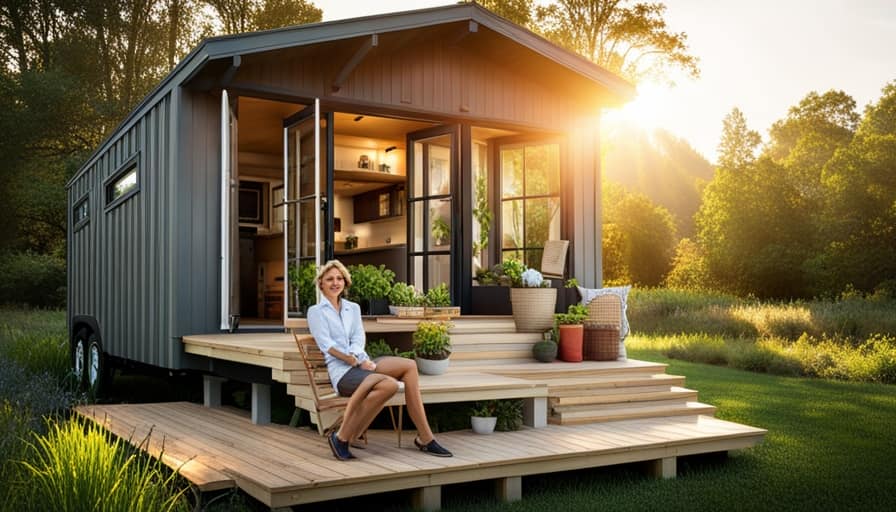
Understanding the Causes of Black Fly Infestations
To understand the causes of black fly infestations, we need to examine their preferred breeding sites and environmental conditions. These tiny pests thrive in moist and decaying organic matter, making the following places common breeding grounds for black flies:
-
Standing water: Black flies lay their eggs in standing water, such as ponds, lakes, and even puddles. It’s crucial to eliminate any stagnant water sources around your house to prevent infestations.
-
Overgrown vegetation: Black flies are attracted to dense vegetation, especially if it’s near water bodies. Trim shrubs, mow your lawn regularly, and remove any overgrown plants to discourage black flies from breeding.
-
Moist organic matter: Black flies lay their eggs in decomposing leaves, grass clippings, and other organic debris. Keep your yard clean and free of debris to reduce the likelihood of black fly infestations.

Understanding these common breeding grounds can help you identify and eliminate the causes of black fly infestations, keeping your home fly-free and comfortable.
Natural Remedies to Eliminate Tiny Black Flies
With a combination of proper sanitation and natural remedies, you can effectively eliminate tiny black flies from your house. One effective natural remedy is making homemade fly traps. These traps can be made using common household items such as apple cider vinegar, dish soap, and a plastic bottle. Simply cut the bottle in half, pour a mixture of apple cider vinegar and dish soap into the bottom half, and place the top half of the bottle inverted into the bottom half. The flies will be attracted to the scent of the vinegar, but the dish soap will prevent them from escaping. Another natural remedy is using essential oils for fly control. Oils such as lavender, peppermint, and eucalyptus have strong scents that repel flies. Simply mix a few drops of your chosen oil with water and spray it around areas where flies are present. By incorporating these natural remedies into your fly control routine, you can effectively get rid of tiny black flies in your house.
| Homemade Fly Traps | Essential Oils for Fly Control |
|---|---|
| – Apple cider vinegar and dish soap mixture in a plastic bottle | – Lavender, peppermint, and eucalyptus oils |
| – Flies are attracted to the vinegar scent but trapped by the soap | – Mix a few drops with water and spray in affected areas |
| – Simple and cost-effective solution | – Oils have strong scents that repel flies |
| – Dispose of trapped flies regularly | – Repeat application as needed |
Chemical Treatments for Getting Rid of Black Flies
By using chemical treatments, you can effectively eliminate black flies from your house. Here are three options to consider:
-
Chemical insecticides: These products are specifically designed to kill insects, including black flies. Look for insecticides that are labeled for use against flies and follow the instructions carefully. Apply the insecticide in areas where black flies are commonly found, such as around windows, doors, and other entry points.

-
Fly traps: There are chemical-based fly traps available that attract and capture black flies. These traps use a combination of chemicals and pheromones to lure the flies in and prevent them from escaping. Place the traps in areas where black flies are present, such as near garbage cans or in the kitchen.
-
Professional exterminator: If you’re dealing with a severe infestation or if chemical treatments haven’t been effective, it may be best to call a professional exterminator. They have access to stronger chemicals and can provide a targeted approach to eliminate black flies from your house.
Remember to always read and follow the instructions on chemical insecticides and traps, and consider the help of a professional if needed.
Preventing Future Infestations of Tiny Black Flies
My best advice for preventing future infestations of tiny black flies in my house is to maintain proper sanitation and eliminate potential breeding grounds.

To maintain a fly-free environment, it’s important to keep your house clean and free from any food or organic debris. Make sure to regularly clean your kitchen, especially the countertops, sinks, and garbage disposal areas. Keep all food stored in airtight containers and promptly clean up any spills or crumbs.
Additionally, it’s crucial to identify and eliminate common breeding grounds for black flies in homes. These include standing water, damp areas, and overwatered plants. Regularly check for any leaks or moisture issues and fix them promptly.
Frequently Asked Questions
Can These Tiny Black Flies Harm Humans or Pets?
I’m not an expert, but I can share that tiny black flies in the house might be annoying, but they usually don’t harm humans or pets. It’s always a good idea to take preventive measures to control their presence.
Are There Any Specific Regions or Climates Where These Black Flies Are More Common?
In certain regions and climates, these pesky black flies tend to be more common. Understanding their preferences can help in devising effective strategies to keep them at bay.

Can These Tiny Black Flies Cause Damage to Plants or Food?
Yes, these tiny black flies can cause damage to indoor plants as they lay their eggs in the soil. They can also contaminate stored food by landing on it and leaving behind bacteria.
How Long Does It Usually Take for Natural Remedies to Effectively Eliminate Black Flies?
On average, natural remedies can effectively eliminate black flies within a few days. However, the exact time may vary depending on the severity of the infestation and the specific remedies used.
Are There Any DIY Traps or Baits That Can Be Used to Catch and Eliminate These Tiny Black Flies?
There are several DIY fly traps and effective baits that can be used to catch and eliminate those pesky tiny black flies. Let me share some knowledge and details on how you can tackle this issue.
Conclusion
So there you have it, a plethora of methods to bid farewell to those pesky tiny black flies that have invaded your humble abode.

From natural remedies to chemical treatments, we’ve covered it all.
Now, armed with this knowledge, you can take control of your home and ensure these unwelcome guests never return.
Happy fly-free living!
I’m Theodore, and I love tiny houses. In fact, I’m the author of Tiny House 43, a book about tiny houses that are also tree houses. I think they’re magical places where imaginations can run wild and adventures are just waiting to happen.
While tree houses are often associated with childhood, they can be the perfect adult retreat. They offer a cozy space to relax and unwind, surrounded by nature. And since they’re typically built on stilts or raised platforms, they offer stunning views that traditional homes simply can’t match.
If you’re looking for a unique and romantic getaway, a tree house tiny house might just be the perfect option.
Beginners Guides
How Do I Get Rid of Tiny Bugs in My House

I have pests in my home that are causing me frustration! They are like small intruders that are appearing all over the place. However, do not worry, as I have conducted thorough research and found effective solutions to eliminate these bothersome pests.
In this article, I’ll guide you through identifying the types of bugs, understanding the causes of infestations, and providing natural and chemical remedies to eliminate them.
Say goodbye to those unwelcome guests and hello to a bug-free home!
Key Takeaways
- Identifying the specific pest by observing droppings or behavior is crucial in getting rid of tiny bugs in the house.
- Proper sanitation practices, such as keeping the kitchen and dining areas clean, are important in preventing bug infestations.
- Natural remedies like herbal insecticides and essential oils can be effective in deterring bugs without the use of harsh chemicals.
- Regular cleaning, sealing cracks, and maintaining a tidy home are essential in preventing future bug infestations.
Identifying the Types of Tiny Bugs in Your House
I can easily identify the types of tiny bugs in my house by observing their physical characteristics and behavior. One of the most common signs of an infestation is the presence of droppings or excrement. Different types of bugs leave different types of droppings, which can help determine the specific pest in your house.

Additionally, observing the behavior of the bugs can provide valuable information. Some bugs are more active during the day, while others are nocturnal. Some bugs may prefer certain areas of the house, such as the kitchen or bathroom.
If you’re unsure about the type of bug in your house, it’s advisable to consult with professional exterminators who’ve the expertise to accurately identify and eliminate the pests.
Understanding the Common Causes of Bug Infestations
One of the most common causes of bug infestations is a lack of proper sanitation practices in the home. Understanding bug behavior and knowing their common household bug habitats can help prevent infestations.
Bugs are attracted to food sources, so it’s important to keep the kitchen and dining areas clean and free of crumbs and spills. Regularly emptying and cleaning garbage cans can also deter bugs from entering the home.

Additionally, bugs thrive in warm and moist environments, so it’s important to fix any leaks or damp areas in the house. Cluttered spaces provide hiding spots for bugs, so keeping the home organized and decluttered can help minimize their presence.
Natural Remedies to Get Rid of Tiny Bugs in Your House
To effectively eliminate tiny bugs in your house, try using natural remedies with ingredients such as vinegar and essential oils. Natural remedies are a great option for those who prefer non-toxic solutions and want to avoid harsh chemicals.
One effective natural remedy is using herbal insecticides. These insecticides are made from plant-based ingredients and can be sprayed in areas where bugs are commonly found, such as corners, cracks, and crevices.
Another natural remedy to consider is essential oils. Certain essential oils, such as peppermint, lavender, and tea tree oil, have insect-repellent properties. Simply mix a few drops of the essential oil with water and spray it around your house to deter bugs.

These natural remedies can be a safe and effective way to get rid of tiny bugs in your house.
Chemical Treatments for Eliminating Tiny Bugs
There are several effective chemical treatments available to eliminate tiny bugs in your house. When it comes to pest control methods, using insecticides is a common and efficient approach. There are various types of insecticides on the market, each with its own advantages and disadvantages.
It’s important to compare different insecticides to determine which one is best suited for your needs. Some insecticides target specific bugs, while others have a broad spectrum of effectiveness. Additionally, consider the application method and the duration of effectiveness. Some insecticides require direct contact with the bugs, while others can be used as a residual treatment.
It’s also essential to follow the safety instructions provided by the manufacturer when using chemical treatments to ensure the well-being of both humans and pets in your home.

Preventing Future Bug Infestations in Your Home
I’ll make sure to regularly clean and seal any cracks in my house to keep bugs from coming in. Effective cleaning techniques are crucial in preventing bug infestations and creating a bug-free environment. Maintaining a clean and tidy home is essential to minimize the presence of bugs. Regularly vacuuming carpets and upholstery, sweeping and mopping floors, and wiping down surfaces will help eliminate any crumbs or food particles that may attract bugs. Additionally, proper food storage is essential to prevent bugs from being attracted to your kitchen. Keeping food in sealed containers and promptly cleaning up spills or crumbs will deter bugs from entering your home. Regularly inspecting and repairing any cracks or gaps in windows, doors, and walls will also help prevent bugs from finding their way inside.
| Cleaning Techniques | Maintenance Tips |
|---|---|
| Vacuum carpets and upholstery | Inspect and repair cracks or gaps |
| Sweep and mop floors | Properly store food to deter bugs |
| Wipe down surfaces | Regularly clean and seal cracks |
| Dispose of trash regularly | Keep a tidy and clutter-free home |
Frequently Asked Questions
Can These Tiny Bugs Cause Any Harm to Humans or Pets?
I’m not sure about the specific bugs in your house, but some tiny bugs can cause harm to humans or pets. It’s important to address the bug infestation promptly to protect your health and take preventive measures to keep them out.
How Long Does It Typically Take for Natural Remedies to Effectively Get Rid of Tiny Bugs?
It typically takes a few weeks for natural remedies to effectively eliminate tiny bugs. However, it’s important to note that results may vary. As for side effects, natural remedies are generally safe for humans and pets.
What Are Some Signs That Indicate a Bug Infestation in the House?
Signs of a bug infestation in the house include seeing live or dead bugs, finding their droppings or eggs, and noticing damage to furniture or walls. Preventing bug infestations involves keeping a clean and tidy home, sealing entry points, and using insect repellents.

Are There Any Specific Areas in the House Where These Tiny Bugs Are Commonly Found?
In my experience, tiny bugs tend to hide in common areas like kitchen cabinets, bathrooms, and near windows. To prevent them, I recommend regular cleaning, sealing cracks, and keeping food stored properly.
Can Certain Weather Conditions or Changes in the Environment Attract These Tiny Bugs Into the House?
Certain weather conditions or changes in the environment can attract these tiny bugs into the house. Factors like warm and humid weather, open windows, and presence of organic matter can make your home more inviting for them.
Conclusion
In conclusion, while it can be frustrating to deal with tiny bugs in your house, there are effective ways to get rid of them.
By identifying the types of bugs and understanding the common causes of infestations, you can take natural or chemical treatments to eliminate them.

Additionally, taking preventive measures can help to avoid future bug infestations.
Remember, with the right knowledge and strategies, you can create a bug-free environment in your home.
I’m Theodore, and I love tiny houses. In fact, I’m the author of Tiny House 43, a book about tiny houses that are also tree houses. I think they’re magical places where imaginations can run wild and adventures are just waiting to happen.
While tree houses are often associated with childhood, they can be the perfect adult retreat. They offer a cozy space to relax and unwind, surrounded by nature. And since they’re typically built on stilts or raised platforms, they offer stunning views that traditional homes simply can’t match.
If you’re looking for a unique and romantic getaway, a tree house tiny house might just be the perfect option.
-

 Beginners Guides2 weeks ago
Beginners Guides2 weeks agoHow To Buy A Tesla Tiny House
-

 Energy Efficiency2 months ago
Energy Efficiency2 months agoBest Tiny Homes For Cold Climates
-

 Beginners Guides1 week ago
Beginners Guides1 week agoTiny House Nation Where Are They Now Stephanie
-

 Tiny House Resources (e.g., legalities, cost, insurance, FAQs)2 months ago
Tiny House Resources (e.g., legalities, cost, insurance, FAQs)2 months agoDo Tiny Homes Need Planning Permission?
-

 Beginners Guides3 weeks ago
Beginners Guides3 weeks agoFrom The Show Tiny House Nation How Many Keep Their Tiny House?
-

 Beginners Guides2 months ago
Beginners Guides2 months agoUsing a Climbing Net For Treehouse Construction
-

 Beginners Guides2 months ago
Beginners Guides2 months agoHow to Build a Treehouse Without Drilling Into the Tree
-

 Beginners Guides3 weeks ago
Beginners Guides3 weeks agoTiny House Nation Who Pays For The Houses





